#Trackwork
Photo
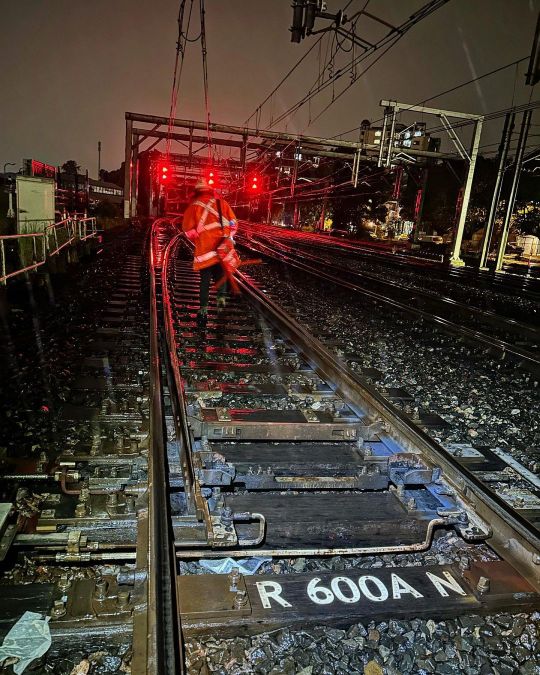
Rain nights on track 🚂 . . . #homebush #sydney #trackwork #trackpoints #trains #nightshift (at Homebush, New South Wales, Australia) https://www.instagram.com/p/CnoLwNmyg4X/?igshid=NGJjMDIxMWI=
4 notes
·
View notes
Text

i had a very long day yesterday so i didn't draw much
#my sona#scribblins#had a very weird and stressful shift at work#then immediately went from work down to the city (3 hour trip involving a bus because trackwork) to watch the new ghibli movie#which was... certainly a movie? i don't really know how i feel about it#anyway then i legged it from the cinema to the train for another 3 hour trip home#got in just before midnight#anyway i think tomorrow i will post crosscode art i have a bunch of sketches and stuff i need to port from twitter
16 notes
·
View notes
Text
it has been a horrible horrible week
3 notes
·
View notes
Text
Gipsyhill at Bognor, with a set of five four-wheel coaches, some four- and some five-compartment, as well as a four-wheel full-brake coach each end.

6 notes
·
View notes
Text
there are 2 stations fairly close to rehearsal. i went to the one with the nicer walk - only to find out it's closed due to trackwork and i have to go to the other one! argh.
1 note
·
View note
Text
Mistaken Journey
I end up on a bus going in the wrong direction.
I misread a sign and get comfortable instead of checking my GPS,
Nodding off from the gentle rocking motions as we navigate back streets and red lights.
The rain outside starts drumming on the windows,
But I am safe here.
I check my phone to see progress,
And realise my mistake.
I get off at the next stop, and figure out how to get to my destination.
Not all mistakes are fatal or carry consequences.
All that matters is how to fix it.
I still arrive on time,
A story richer.
#2506#in my defense there's trackwork and things are a bit wacky#but yeah took me an extra half hr#writing#original poem#poetry#spoken word#poem#spoken word poetry#daily poem#poems
0 notes
Photo

The site worker tracking system, designed to improve proper safety, efficiency, and accountability on the working sites. This system will allowing us to the monitor the location and activities of all workers in real-time, and also allows to track the workers & contractors.
Know more in our Website:-https://informapuae.com/
0 notes
Photo

#trackworker @nycgov #fitnessphotographer #batzography @batz_skinner @planetfitness @bodybuildingcom @newbalance #newyorkcity #newyorker #nycafternoons #nycisafullbodyworkout #lifeasithappens #lifeisbeautiful @batzstyle #batzstyle #batzwear @fitreslife @fashionweek #hautecouture #actor #artist #america #anatomy #fitness #trainer #trainees #bbbatz #batz #body #nyc (at Manhattan, New York) https://www.instagram.com/p/ChkGMYTutW_/?igshid=NGJjMDIxMWI=
#trackworker#fitnessphotographer#batzography#newyorkcity#newyorker#nycafternoons#nycisafullbodyworkout#lifeasithappens#lifeisbeautiful#batzstyle#batzwear#hautecouture#actor#artist#america#anatomy#fitness#trainer#trainees#bbbatz#batz#body#nyc
0 notes
Text

South Station Arrival
Just about a year into the absorption of the New Haven by Penn Central you would never know it by this three car RDC train arriving at South Station this Christmas Eve. For some reason, as evidenced by the missing semaphore blades, some of the trackwork has been rendered inoperative or has been removed.
Photographed by Ron DeFilippo, December 24, 1969.
#commuter train#pc#penn central#nynh&h#new haven railroad#1969#boston#trains#passenger train#history#boston south station#massachusetts#christmas eve
26 notes
·
View notes
Text
Traintober 2023: Day 10 - Happiest
Some of the Engines, at their Happiest:

Culdee:
Culdee is at his happiest when he’s scaling the Fell with his faithful coach, Catherine – especially early in the morning, with the sun rising to the east. When he can feel the crisp wind blow across his tanks, when he can see the entire island laid out below him, the engines mere specks in the distance, his funnel closer to the cloud than the ground.
“It’s gorgeous up here,” murmured Culdee to Catherine.
“Oh yes,” hummed Catherine. “There’s no place better in the whole world.” Culdee couldn’t agree more.
Mike:
Mike is at his happiest in the evenings, when the moon is just rising and his train is compiled of the last of the ballast collected from the workings. The air is cool, and the trees seem to dance in the breeze, the leaves rustling with woodland creatures all awakening from their slumber to begin foraging. There is no Rex to antagonise him, no Frank to make snippy comments about trackwork. It’s perfect.
“I love this,” Mike admitted freely into the wind. And though his trucks didn’t reply, it felt like for a brief moment the wind spurred them onwards.
Rusty:
Rusty is always happiest when working on the track. It may seem cliché, but the little diesel loves the work – being able to help the other engines run smoothly along the rails, and knowing that it was their handiwork that achieved that. Hearing the praise from the engines only added to the feeling.
“Nice work today, Rusty!” called Sir Handel as he steamed by the little diesel with a passenger train.
“Thank you!” grinned Rusty. Ah yes, there was nothing in the world that Rusty would exchange than to hear that their friends were happy with their work.
Mavis:
Mavis finds travelling down the branchline to be the most joyful experience in the world. As much as she loves working in the quarry, making jokes with the workers (Thomas says she’s “uncouth”, Toby knows the best phrases to get a laugh out of the men) – well, her favourite job is heading all the way down to the harbour. Getting to go beyond her usual running grounds and see a piece of the world.
“Morning Terrence!” chirped Mavis.
“Oh, ‘Ello Mavis!” grinned Terrence, chugging over. “Nice ta see you! Heading for the harbour?”
“Oh yeah – I’ve got stone for a ship. It’s great being out of the quarry – less dust down here!” Terrence just laughed, and Mavis smiled broadly. Yes, this was where she was happiest.
The thing is, that almost all the engines could also agree on one other place where they are happiest: with each other. For all their arguments, they are family – each and every one of them, and they wouldn’t trade their family for the world.
Back to Master Post
#fanfiction writer#weirdowithaquill#railway series#thomas the tank engine#railways#traintober#traintober 2023#happiest#ttte mike#ttte culdee#ttte mavis#ttte rusty
29 notes
·
View notes
Photo
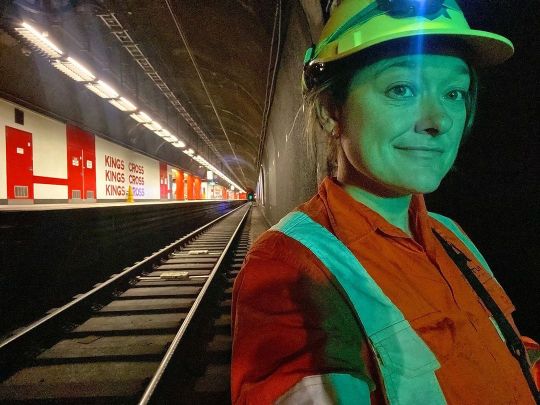
Rather eery working in the tunnels in the city . . . #dontgoontraintracks #railwayworker #railwayshutdown #trackworkers #kingcrossstation #sydney (at Kings Cross railway station, Sydney) https://www.instagram.com/p/CmJHkEzyhGj/?igshid=NGJjMDIxMWI=
4 notes
·
View notes
Photo
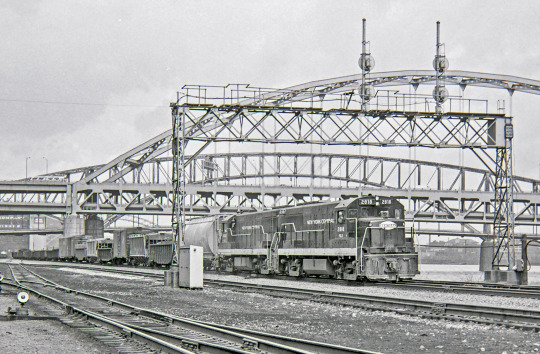
Two nearly-new Pittsburgh and Lake Erie GE-built U28B locomotives, led by 2818, pass through the station trackwork at Pittsburgh's P&LE headquarters, in March, 1966, with an eastbound freight train.
#p&le#pittsburgh & lake erie#nyc#new york central#1966#trains#freight train#history#pittsburgh#pennsylvania
36 notes
·
View notes
Text

[1963]
“It was that coach, sir,” blustered Lord Harry. “She never-”
“No tales.” Mr. Richards interrupted, his graying brow locked in a stern glare. “The derailment today was your fault, and you know it. You upset our passengers, compromised the trackwork, and damaged yourself by being a swanky little twerp and taking risks. I will not have such carelessness on my railway.”
“But sir-”
“One more word of excuses from you, Number 6, and I’ll have whatever’s left of your wheels and running motion stripped off and given to Dooiney!”
A long silence hung in the yard.
“N-number 6?” The red engine finally asked.
“Yes. Number 6. The workers are going to take off your nameplates first thing in the morning - after they’ve finished cleaning up the mess you made.”
“You- you can’t!”
“You forget. You are an engine on my railway.” Mr. Richards aggressively pointed his cane between the engine’s eyes. “I gave you that name, I can sure as hell take it away. Maybe it’ll take this foolish attitude with it.” He sighed, and strode away, producing a lighter and a cigarette from his waistcoat as he went.
Silence once again reclaimed the mountain railway.
“Perhaps,” Ernest said, at last, “it’s time we told you why our railway lacks a number 1.”
#ttte#thomas and friends#thomas the tank engine and friends#railway series#rws#ttte godred#ttte ernest#ttte wilfred#ttte culdee#ttte shane dooiney#ttte no.6#ttte patrick (cfr)#ttte lord harry#mountain engines#happy easter have some angst
3 notes
·
View notes
Text
Goodbye-eee!
Sydney
27 May 2023
The journey of a thousand miles, it seems, begins with a half-dozen trains.
We left Canberra just before 7am, travelling by the Xplorer train service as far as Campbelltown. Normally this service would take us all the way into Sydney, but the spectre of trackwork loomed over us and we had to change to the suburban network. We caught a train from Campbelltown to Wolli Creek, changed there, and carried on to Hurstville, which was to be our base of operations for the weekend. We left our stuff there and returned to the station, catching a fourth train to Town Hall.

I am something of a regular at Peter Nathan Toy Soldiers, by which I mean I go there maybe twice a year. I am sure this counts as being a regular. One might perhaps find it paradoxical that I wax philosophical about the horrors of war while collecting my little pewter troopers. My response is to paraphrase the great author H. G. Wells, who, when the paradox of his being a pacifist and an avid miniature wargamer was brought up, responded that ‘tin soldiers do not leave tin widows and tin orphans.’ And I like to think I have a bit of taste as to what I collect - I don’t collect wounded soldiers (as much as I tease Mum about getting that bayoneted Jacobite - she likes Outlander, you see), and the SS are completely verboten, thank you very much. But I am also keenly aware that this hobby attracts what we might charitably call oddballs. I overheard the owner in a discussion about how the most popular topics for toy soldier collection are Romans and the Nazis. Make of that what you will.
Perhaps I’m being too judgemental. I’m sure there are people who think my collection of British redcoats is problematic. Not everyone with an interest in the Nazi military is a neo-Nazi - but these days, I find it helps to maintain a healthy scepticism.

After this, I headed down to Darling Harbour and walked around the precinct of the National Maritime Museum. There’s little WWI-related there, of course - I’m not certain a single WWI Australian ship survives - but it’s still always well worth a look. One thing that annoys me is the new ‘action stations’ building - I’m sure it’s an excellent educational aid, but it blocks what used to be a good photographic angle of HMAS Vampire’s port side. I had hoped to see the replica of Janzoon’s Dufkyen, but it seems it was at sea when I was there. The submarine Onslow and the patrol boat Advance seemed in good order, and the Endeavour replica was a delight to look over as always. Of particular note was the Krait, a captured Japanese fishing boat used by Australian and British commandos in a sabotage operation in Singapore harbour - it tends to be obscured by something when I go to the museum, so it was nice to see it unobstructed today.
After that, I walked back to the Queen Victoria Building via JB-HI-FI, where I picked up a bluetooth mouse that doesn’t work. I suppose that’s twenty dollars I’ll never see again. We caught the train back to Hurstville, picked up some groceries and some KFC, and returned to the hotel, where I write this now. Tomorrow, we’ll be heading in to Hyde Park Barracks and the Anzac Memorial, and taking a trip on the ferry to Manly. I’m sure I’ll have a little more to say about all that.

7 notes
·
View notes
Text
Early Victoria State Locomotives - 1872-1880. Alternate title: What the Hell is a Buzzwinker?!
Meikle was right in it, and the proverbial midden was well on its way to the windmill. The requisite load was 100 tons up a 1-in-50 gradient. He could design a small 4-4-0, which would be happy on the light trackwork, but which would only handle 80 tons, or a small-wheeled goods engine, which could handle the traffic volumes and hammer the track. He chose the latter, creating the aforementioned pair of designs - a goods 0-6-0 and a passenger 2-4-0.
In two weeks he was able to call tenders for their manufacture - in the past, with experienced English builders, it was customary to send only vague specifications, and leave the bulk of design work to the builder. But there were no experienced builders yet in the colony, and Meikle had no chance of getting ready an advanced engineering drawing in the time allotted.
So it was, while prospective contractors readied their estimates, Meikle turned out those last two 2-4-0 conversions mentioned previously, and also rebuilt No.34 and 36 into little 0-6-0 and 2-4-0 well-tanks.
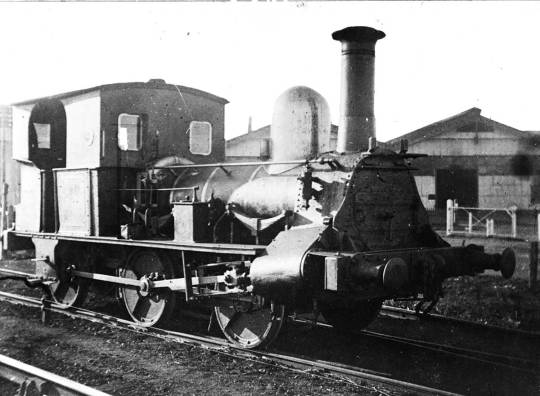
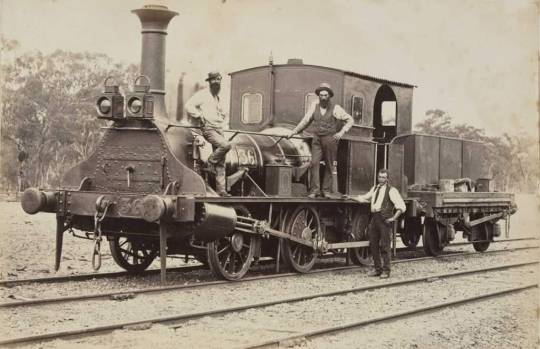
The contract for fifteen engines to Meikle's new design was awarded to Pheonix Foundry, with nine 0-6-0s and six 2-4-0s to be built. Together with the two pattern engines from England, that left 17 locomotives, all to unproven designs, on order, with no opportunity for testing.
Meikle saved money on his new engines as best he could, with the object of matching the cost of imported machines. The boiler was domeless, with a plain safety valve cover, as well as commonality of as many parts as possible between the two types. He was also aware of the forceful arguments made about light railway speeds, and that they should be kept very low. Thus, he gave the new 0-6-0s 3'6" wheels, and the passenger engines 4' driving wheels, but paired with a firebox equal to any of the larger engines, but with a lighter and smaller boiler barrel.
Shortly before the last of the Greenbacks was finished, Williamstown began working on prototypes for the forth-coming outside-cylindered 0-6-0s, with Phoenix to cast the cylinders. The motion had to be designed specially, with the problems being worked out there and then on the workshop floor - the results being passed to Phoenix for the fifteen production engines.
In recognition of the Williamstown workmen, Meikle had one of the prototype engines, No.105, head their annual picnic train to Ballarat that December, 1873. With a heavy train of sixteen coaches, the locomotive seemed to be doing all right until another design flaw manifested itself. A piston rod broke and in so doing the cylinder head was damaged - a man had to run back to Lethbridge, and a relief from Geelong telegraphed for. The picnic lunch was had as an afternoon tea, and work on the new locomotives was halted until the fault was worked out.

A bit of a war of words broke out between The Age and The Ballarat Star, augmented by Higinbotham later reporting that locomotives manufactured at Phoenix were not as well-built as those from America or England (although that's not to say those last were perfect, see the 'Yorkies'. Higinbotham's report also added that the Victoria Rlys. would be better off building its own locomotives at Williamstown.
Phoenix had laughed all the way to the bank, though, having secured the contract for the Greenbacks, they outfitted their works to the tune of £7000, and had plenty of political leverage with the loud Major at the wheelhouse. They delivered the new light lines engines between July 1874 and May '75, costing roughly £3,600 a piece - £1200 more than a similar engine from England. The six-coupled ones became the U class, and the four-coupled the K class.
Meikle was, at least in public, happy with his new outside-cylindered machines. There was a prevailing problem, though - the whole raison d'etre of these engines was low speed, but they were thrashed, and this was detrimental to the new, unsettled track. The Resident Engineer of the new lines condemned both the trackwork and the engines in a report he submitted in 1874. Mr. Greene reckoned they were heavier than Meikle's estimate of 22 tons, and was right - although they had no way of proving it at the time. At any rate, the main problem was the horizontal motion - they lurched ponderously at low speed and were down-right hair-raising when pushed. The waddle, and the great cost, lead to the enginemen naming them 'Buzzwinkers' after Ellen Miles, prominent pickpocket around Ballarat.

At the same time as Greene's report, also arrived the aforementioned pattern engines. Without the protectionists forcing both Meikle and Pheonix Foundry to undertake all the excess work of building the Buzzwinkers, the light lines would have been a success at the first. The two pattern engines entered service in 1874, and proved quite equal in power to a Buzzwinker, more stable at any speed, and arguably better-looking. The Beyer, Peacock 0-6-0, and the 2-4-0, (T class and F class) were copied in good numbers, with F class No.98 being stripped to the last bolt, and these engines would have managed fine. But Phoenix were instead saddled with developing six designs rather than just these two, and indeed everyone lost out in some way.
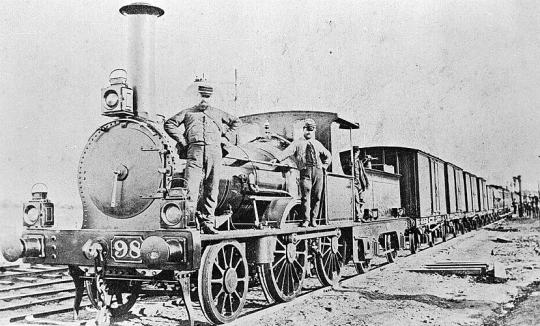
With questions being asked in Parliament, and the light lines growing, Meikle was encouraged to have another go at making an engine suitable for the light lines. They borrowed a Melbourne & Hobson's Bay United Rly. passenger 4-4-0 tank, to compare with No.114, a passenger Buzzwinker, and No.100, the pride of Williamstown workshop. (It is worth noting that on the VR system, passenger engines were numbered evens, and goods engines odds.) The 4-4-0T would later become the C class, and was a 'British-American', at least as far as being a British 4-4-0.


Higinbotham had been on a couple of year's tour around America, and returned for these trials in early 1876. He was delighted by the bogie engine's smooth riding, and disgusted by the effect of No.114's impetous motion on the track. He wasn't too taken with the pattern engines - they were much better than the Buzzwinkers, he thought, 'but they want a bogie truck.'
Meikle had overseen two 4-4-0s being constructed at Williamstown, and was calling tenders for eight more by June of 1876. The two prototypes left Williamstown early the next year, using second-hand boilers. He also placed orders for American bogie coaches, and what large and splendid vehicles they were! The Age thought them quite fit for royalty, which speaks volumes as to the style of carriages in use before. They weren't especially popular with the management, as they weren't always full, but they were both an improvement on comfort and convenience.

Highinbotham was by this point a convert of American schools of thought on locomotives and rolling-stock, and although he didn't like the idea of light lines from the start, he had to make the best of them to keep out the narrow-gauge advocates, and if the American eight-wheeler could help him to succeed, so much the better. He inserted into his report that the railway should build its own locomotives where possible, as the lack of any real alternative to Phoenix obliged VR to buy inferior engines at steep rates, however this report was sat on until Phoenix had been granted the contract for Meikle's 4-4-0s - the new Minister for Railways, J. Jones, was a representative of Ballarat West, and Phoenix Foundry was in his electorate!
The Engineer-in-Chief's words escaped notice for a cool three-and-a-half weeks, before indignant protectionists got wind of the situation, and there was a further eruption in the Legislative Assembly. They were supported, too, with very grave questions being levied against Higinbotham's engineering prowess. He had, in his report, spotlighted the Buzzwinkers, but his habit of ''ringing in' superlatives' had given the impression all the Phoenix machines were faulty - strictly untrue. Meikle had, interestingly, supported the Phoenix engines, and Major Smith quoted his support, but then the protectionists turned on Meikle too.
'The grave accusations levelled at the engines are properly chargeable upon the Railway Department and its responsible officers. The manufacturers complain that the design of the engine is bad, and who, we ask, is the author of the design?'
The General Manager of Phoenix Foundry was livid, and at once all the good-will gained at the Locomotive Branch picnic vanished. Support for the Foundry was so high in Ballarat that the town was bedecked with bunting when the first engines were delivered. The Foundry itself wasn't particularly pleased either, despite having got the contract for the eight Meikle 4-4-0s, it was displeased at having to abandon the patterns got from stripping down the English 2-4-0 No.98.
The worst part was they had a point. A fifth new design in as many years, and for an engine that in power was not dissimilar to an F class - speaking practically, yet another new type added little, despite the excellent riding qualities of the Williamstown 4-4-0s.
Meikle was now 57 years old, and working for a Government railway, pushed and pulled by press and public, must have been a very trying experience for a man used to working for private railways. He resigned in January 1877, a development he had hoped to keep private, but of course the papers found out the next day. It wasn't a good look, as he had resigned on the same day motions were made toward establishing another Board of Inquiry.
The Board of Inquiry was chaired by the Overseer of Locomotives for the NSWGR, and also in attendance was William Thow, Loco. Engineer of the South Australian Railways. (He is worthy of note - if you've ever seen an Australian engine with a cab sporting a single circular side-window, he's the reason.) The Board of Inquiry was formed to answer:
Were the present locomotives in use on the light railways suitable for the job?
Were home-built locomotives as good as those from England?
The Board spent two days travelling over light railways, on the six different engines types then employed. Meikle's prototype 4-4-0 impressed them with its easy ride qualities, especially in curves. No.125, the pattern 0-6-0 (yet to be copied) was surprisingly easy even at speed.
They saw their first Buzzwinker at Maryborough. No.114, she was the engine who had been trialled along with No.100 and the M&BHUR engine. She was a passenger Buzzwinker, much less steady on the curves than the prototype 4-4-0 No.38, but not nearly so bad as the permanent way staff had warned them of. She took them out to Avoca, then to Creswick. There they waited at the foot of the two-mile incline of 1-in-50, for the regular 'mixed' from Ballarat.

It was considered good economics to load the engines right up to the maximum they could drag up the hills, and the temptation to make up for slow climbing with spirited downhill runs was a strong one. And here came Buzzwinker No.115, following exactly that mode of thinking, 'hurtling down the incline at about 35mph. This at last was one of the goods Buzzwinkers so much complained of, throwing itself about like a wild thing, its machinery flying around at almost twice its optimum design speed.'
From Creswick, the disillusioned company were whisked into Ballarat by one of Meikle's 2-4-0 conversions. It was rather too heavy for the light lines, but as some of the goods Buzzwinkers had been banned from the area, its presence was a necessity. It was smooth enough, all told, as was No.128, one of Phoenix's copies of the Beyer, Peacock pattern 2-4-0.
When they reached Buangor, they reacquainted themselves with No.115, on the 'mixed' to Ararat, once more loaded down to the gunwhales. The company was brought onto the footplate, and at ten miles an hour felt 'a sinuous motion, distinct, regular, and very apparent at low speeds, combined with a slight rolling motion, equally regular and distinct, and both conformable with the revolutions of the wheels.' Piling head-long downhill at 40mph, the ride became 'a hard, irregular, jerking motion, inconformable to the movement of any part of the machinery.'
F-class No,128 took them to Stawell, where they caught No.119, another six-coupled Buzzwinker, and even worse than her sister. They also watched No.123 climb up an incline near Buangor, lurching back and forth, and saw that the track had 'suffered more displacement and injury than any of the lines seen the previous day' (from which the 0-6-0 Buzzwinkers were banned.)
Last of all to be reviewed was No.121, dragging a heavy train up Warrenheip Bank at nine miles an hour, with its stomping much more marked than any of the others. Even when coasting it was 'uncommonly rough'. It was also under this inquiry that Thow brought accurate weighing equipment, and discovered that the engines were indeed overweight, as had been claimed some years earlier. The Buzzwinkers were roundly condemned as unsuitable for any work other than over the heavily-built and heavily-graded Beechworth line.
Meikle's rebuttal was that this was the intention for the engines from the first, although that does not seem to be strictly true. Incidentally, three goods Buzzwinkers drew a fourteen-coach special on the opening of the Beechworth line in 1876, nearly running out of water in the process.
It is with regret I say that in the aftermath of the report by the Board of Inquiry, on which Meikle was not, the man was made the scapegoat of the whole affair, and it is unsurprising that he returned to England not long after. During his time at Williamstown he had created seven new engine classes, and rebuilt two others, the only ones much complained of being the Buzzwinkers, and those were developed under great outside pressure and with every design factor restricted. All his locomotives were constructed locally, and all were at least fit for purpose. Even the Buzzwinkers lurched on another thirty years, being re-cylindered, fitted with air-brakes, and generally improved in common with the fleet as a whole.
In 1877, two American 4-4-0s, all-American, too, were put into service, followed by Meikle's eight 4-4-0s from Phoenix, later still ten more F-class 2-4-0s (it turned out Meikle's 4-4-0 really was no better than the Peacock design), and last of all in 1880 the ideal colonial locomotive was found, an American ten-wheeler.
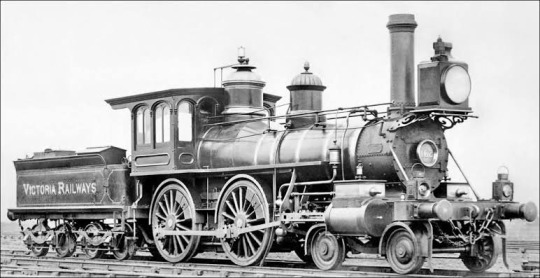
13 notes
·
View notes
Text
Have experienced an actual relevant, well targeted ad on Tumblr for the first time - yes, thank you for telling me about the upcoming scheduled trackwork on my train line! However, I'm now imagining some employee of cityrail choosing to buy add space on fucking Tumblr and that's hilarious to me
2 notes
·
View notes